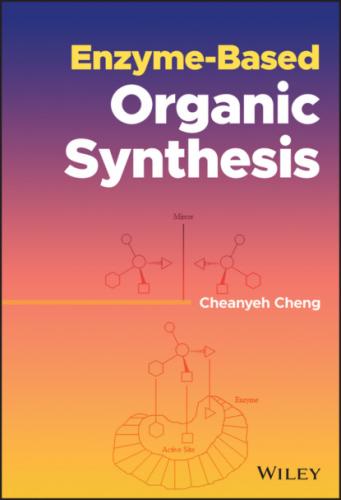Since serine‐threonine kinase, a polo‐like kinase 1 (PLK1), is a key regulator of mitotic progression and cell division in eukaryotes and is highly expressed in tumor cells, it is considered a potential target for cancer therapy. To synthesize the most promising PLK1 inhibitor candidates, thiophene‐benzimidazole and imidazopyridine, for chemotherapy, enantioselective reduction of o‐chloroacetophenone is preferred to produce the chiral key intermediate, (S)‐1‐(o‐chlorophenyl)‐ethanol, for their synthesis (Scheme 2.34) by whole‐cell catalyst of recombining E. coli and recombining S. cerevisiae [146]. The recombinant xylose reductase was from Candida tenuis.
Scheme 2.34 Asymmetric reduction of ketone precursor o‐chloroacetophenone with recombining microorganism toward chiral alcohol product.
Aprepitant (Emend®), a trichiral compound, is a neurokinin‐1 (NK‐1) receptor antagonist that has been approved by the United States and Europe to treat moderately and highly emetogenic chemotherapy for the prevention of acute and delayed chemotherapy‐induced nausea and vomiting. According to its structure (Figure 2.2), 3,5‐bis(trifluoromethyl) acetophenone was used as the starting material to synthesize asymmetrically the key intermediate, chiral (1R)‐[3,5‐bis(trifluoromethyl)phenyl] ethanol, of aprepitant (Scheme 2.35) [147–149]. In the synthesis, a novel bacterial strain Leifsonia xyli HS0904 was isolated from soil that exhibits R‐stereospecific carbonyl reductase. Under the optimal conditions, the best yield of 62% and an enantiomeric excess of 99.4% for the product was obtained with resting cells.
An intermediate of amphetamine and amphetaminil, (S)‐1‐phenyl‐2‐propanol, has been prepared from the simple ketone, 1‐phenyl‐2‐propanone, via bioreduction with 99% e.e. but low productivity through growing cells of R. erythropolis. The substrate inhibition of the biotransformation with growing cells was solved by stepwise feeding, while product inhibition was solved by repeated removal of product using methods such as centrifugation, absorption with resin, and second phase. Higher productivity can be obtained for the reduction of 1‐phenyl‐2‐propanone with resting cells through cofactor regeneration and recycling by the addition of glucose and permeabilized cells of B. subtilis [150].
Figure 2.2 Structure of aprepitant.
Scheme 2.35 The asymmetric synthesis of 3,5‐bis(trifluoromethyl) acetophenone to (1R)‐[3,5‐bis(trifluoromethyl)phenyl] ethanol.
The family of imidazole derivatives, including miconazole, econazole, isoconazole, ketoconazole, sertaconazole, and sulconazole, is well known for antifungal imidazolium compounds. Miconazole and econazole are usually employed in the treatment of vaginal diseases and several fungal infections in the skin of both human and animals by interfering with ergosterol biosynthesis of fungal organisms. Since the therapeutic efficacies of their enantiomers were usually different, the demand for synthesis of optically pure compounds rather than their racemates is required. However, the synthesis of miconazole and econazole single enantiomers with asymmetric chemical transformations [151–154] was rarely reported. Recently, a simple and novel bioreduction of prochiral ketones using ADHs has been applied for the synthesis of the precursors of miconazole and econazole single enantiomers. Then the target fungicides miconazole and econazole were produced from corresponding enantiomeric pure precursors by a series of chemical modifications. The best results were the synthesis of enantiopure precursor, (R)‐2‐chloro‐1‐(2,4‐dichlorophenyl)ethanol, from 2‐chloro‐1‐(2,4‐dichlorophenyl)ethanone using screened ADHs under very mild conditions (Scheme 2.36) [155].
The use of S. cerevisiae (baker’s yeast) for the reduction of ketones or aldehydes may result in mixtures of products due to the existence of a variety of reductases possessing overlapping substrate specificity and mixed stereoselectivity [156]. Therefore, S. cerevisiae and the gram‐negative bacterium E. coli were overexpressed with gene encoding the NADPH‐dependent aldo‐keto reductase YPR1 and compared for producing optically active alcohols through whole‐cell bioreduction. The NADPH‐dependent carbonyl reduction of bicycle[2.2.2]octane‐2,6‐dione to produce optically pure (−)‐(1R,4S,6S)‐6‐hydroxy‐bicyclo[2.2.2]octane‐2‐one was used as a model reaction (Scheme 2.37). High purity of the (−)‐keto alcohol (>99% e.e., 97–98% de) was obtained for both engineered microorganisms. However, E. coli had higher initial rate but S. cerevisiae continued the reaction longer to give a higher substrate conversion (95%). S. cerevisiae also demonstrated higher viability during reaction than E. coli [157].
Scheme 2.36 Bioreduction of α‐haloketones in aqueous medium using different alcohol dehydrogenase followed by a series of chemical modifications to optically pure miconazole or econazole.
Scheme 2.37 E. coli or S. cerevisiae catalyzed reduction of bicycle[2.2.2]octane‐2,6‐dione to (−)‐(1R,4S,6S)‐6‐hydroxy‐bicyclo[2.2.2]octane‐2‐one and (+)‐(1S,4R,6S)‐6‐hydroxy‐bicyclo[2.2.2]octane‐2‐one.
The asymmetric reduction of β‐ketoesters mediated by microorganisms has become a standard method for the synthesis of chiral β‐hydroxyesters [158, 159]. Recently, the immobilization of ADH from permeabilized brewer’s yeast on derived attapulgite nanofibers through glutaraldehyde covalent binding for the bioreduction of ethyl 3‐oxobutyrate (EOB) to ethyl (S)‐3‐hydroxybutyrate ((S)‐EHB) was investigated. The effect of immobilization on ADH activity
